Critical Evaluation of Google's Marketing Practices and Strategies
VerifiedAdded on 2022/08/11
|6
|1007
|17
Report
AI Summary
This report provides a critical evaluation of Google's marketing practices, focusing on its target markets and the umbrella branding strategy. It begins by assessing Google's diverse target audiences, ranging from students and everyday consumers to businesses, highlighting the various products and services Google offers, such as Google Search, Adsense, Adwords, and Google Play. The analysis then delves into Google's adoption of an umbrella branding strategy, explaining its benefits, such as enhanced marketability and the leveraging of existing brand reputation, while also acknowledging potential weaknesses, such as the risk of quality fluctuation and the impact of a single product's poor reputation on the entire brand. The report references key marketing concepts and academic sources to support its arguments, providing a comprehensive overview of Google's marketing approach.

Running head: MARKETING
Global Marketing
Name of the Student:
Name of the University:
Author Note:
Global Marketing
Name of the Student:
Name of the University:
Author Note:
Paraphrase This Document
Need a fresh take? Get an instant paraphrase of this document with our AI Paraphraser
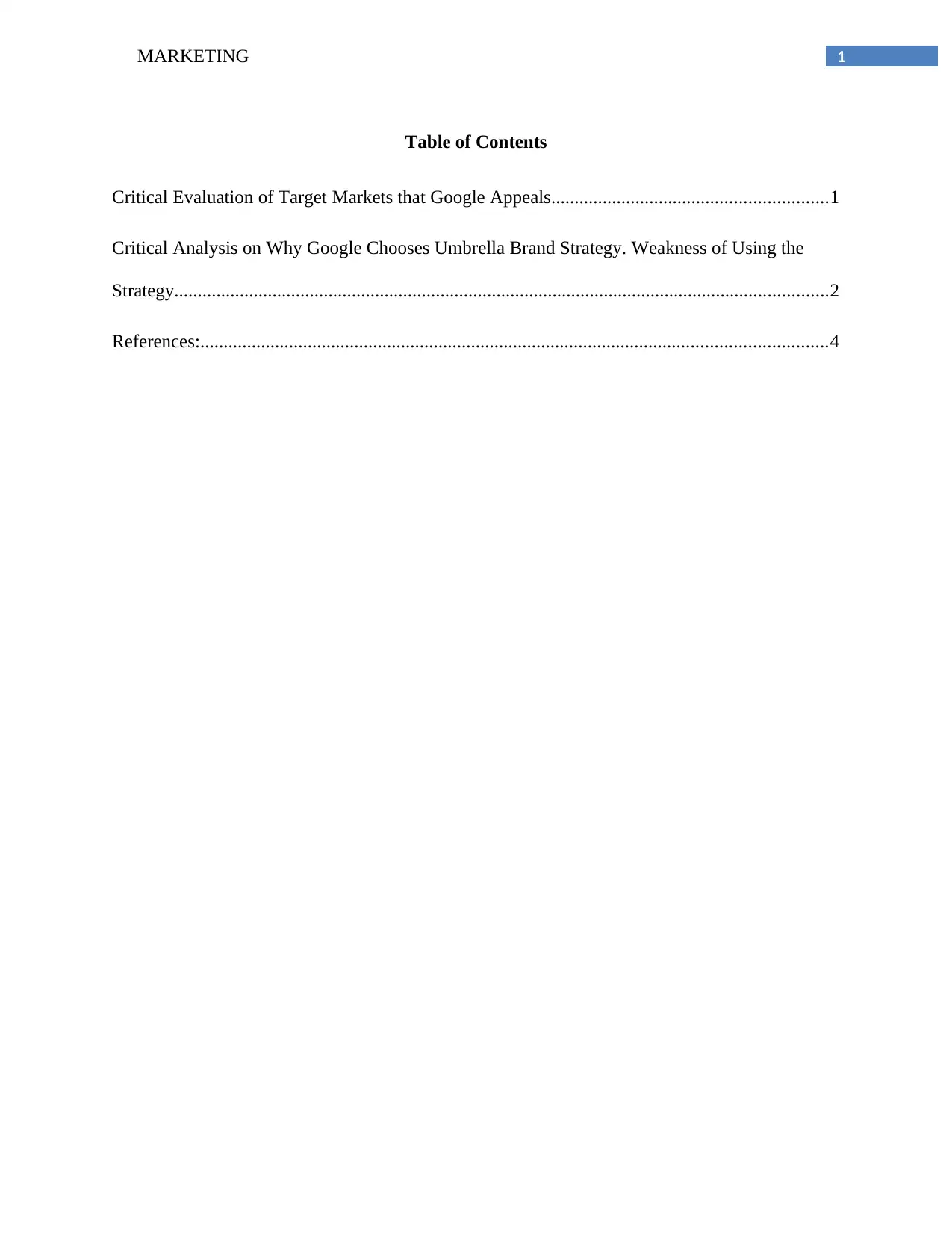
1MARKETING
Table of Contents
Critical Evaluation of Target Markets that Google Appeals...........................................................1
Critical Analysis on Why Google Chooses Umbrella Brand Strategy. Weakness of Using the
Strategy............................................................................................................................................2
References:......................................................................................................................................4
Table of Contents
Critical Evaluation of Target Markets that Google Appeals...........................................................1
Critical Analysis on Why Google Chooses Umbrella Brand Strategy. Weakness of Using the
Strategy............................................................................................................................................2
References:......................................................................................................................................4
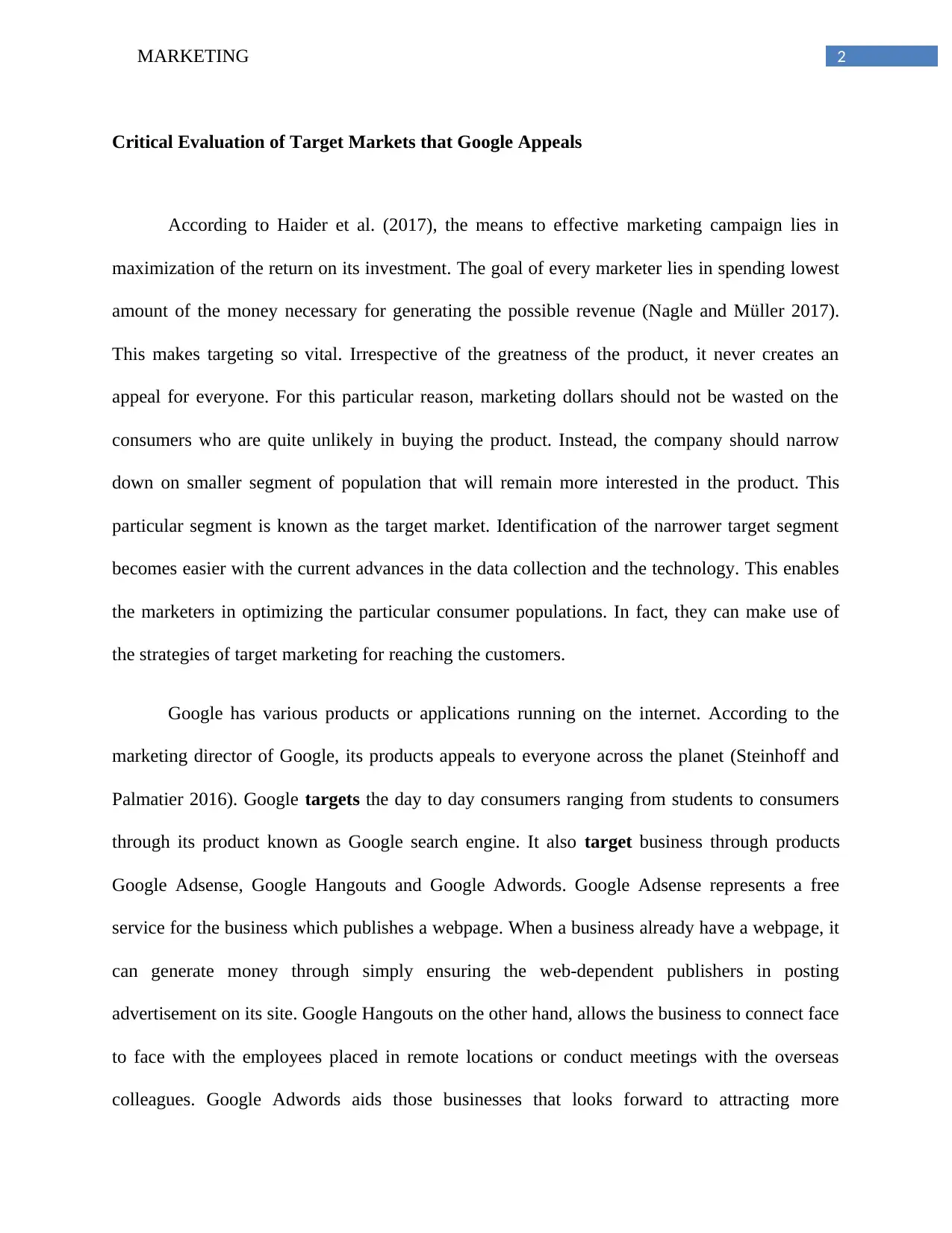
2MARKETING
Critical Evaluation of Target Markets that Google Appeals
According to Haider et al. (2017), the means to effective marketing campaign lies in
maximization of the return on its investment. The goal of every marketer lies in spending lowest
amount of the money necessary for generating the possible revenue (Nagle and Müller 2017).
This makes targeting so vital. Irrespective of the greatness of the product, it never creates an
appeal for everyone. For this particular reason, marketing dollars should not be wasted on the
consumers who are quite unlikely in buying the product. Instead, the company should narrow
down on smaller segment of population that will remain more interested in the product. This
particular segment is known as the target market. Identification of the narrower target segment
becomes easier with the current advances in the data collection and the technology. This enables
the marketers in optimizing the particular consumer populations. In fact, they can make use of
the strategies of target marketing for reaching the customers.
Google has various products or applications running on the internet. According to the
marketing director of Google, its products appeals to everyone across the planet (Steinhoff and
Palmatier 2016). Google targets the day to day consumers ranging from students to consumers
through its product known as Google search engine. It also target business through products
Google Adsense, Google Hangouts and Google Adwords. Google Adsense represents a free
service for the business which publishes a webpage. When a business already have a webpage, it
can generate money through simply ensuring the web-dependent publishers in posting
advertisement on its site. Google Hangouts on the other hand, allows the business to connect face
to face with the employees placed in remote locations or conduct meetings with the overseas
colleagues. Google Adwords aids those businesses that looks forward to attracting more
Critical Evaluation of Target Markets that Google Appeals
According to Haider et al. (2017), the means to effective marketing campaign lies in
maximization of the return on its investment. The goal of every marketer lies in spending lowest
amount of the money necessary for generating the possible revenue (Nagle and Müller 2017).
This makes targeting so vital. Irrespective of the greatness of the product, it never creates an
appeal for everyone. For this particular reason, marketing dollars should not be wasted on the
consumers who are quite unlikely in buying the product. Instead, the company should narrow
down on smaller segment of population that will remain more interested in the product. This
particular segment is known as the target market. Identification of the narrower target segment
becomes easier with the current advances in the data collection and the technology. This enables
the marketers in optimizing the particular consumer populations. In fact, they can make use of
the strategies of target marketing for reaching the customers.
Google has various products or applications running on the internet. According to the
marketing director of Google, its products appeals to everyone across the planet (Steinhoff and
Palmatier 2016). Google targets the day to day consumers ranging from students to consumers
through its product known as Google search engine. It also target business through products
Google Adsense, Google Hangouts and Google Adwords. Google Adsense represents a free
service for the business which publishes a webpage. When a business already have a webpage, it
can generate money through simply ensuring the web-dependent publishers in posting
advertisement on its site. Google Hangouts on the other hand, allows the business to connect face
to face with the employees placed in remote locations or conduct meetings with the overseas
colleagues. Google Adwords aids those businesses that looks forward to attracting more
⊘ This is a preview!⊘
Do you want full access?
Subscribe today to unlock all pages.

Trusted by 1+ million students worldwide
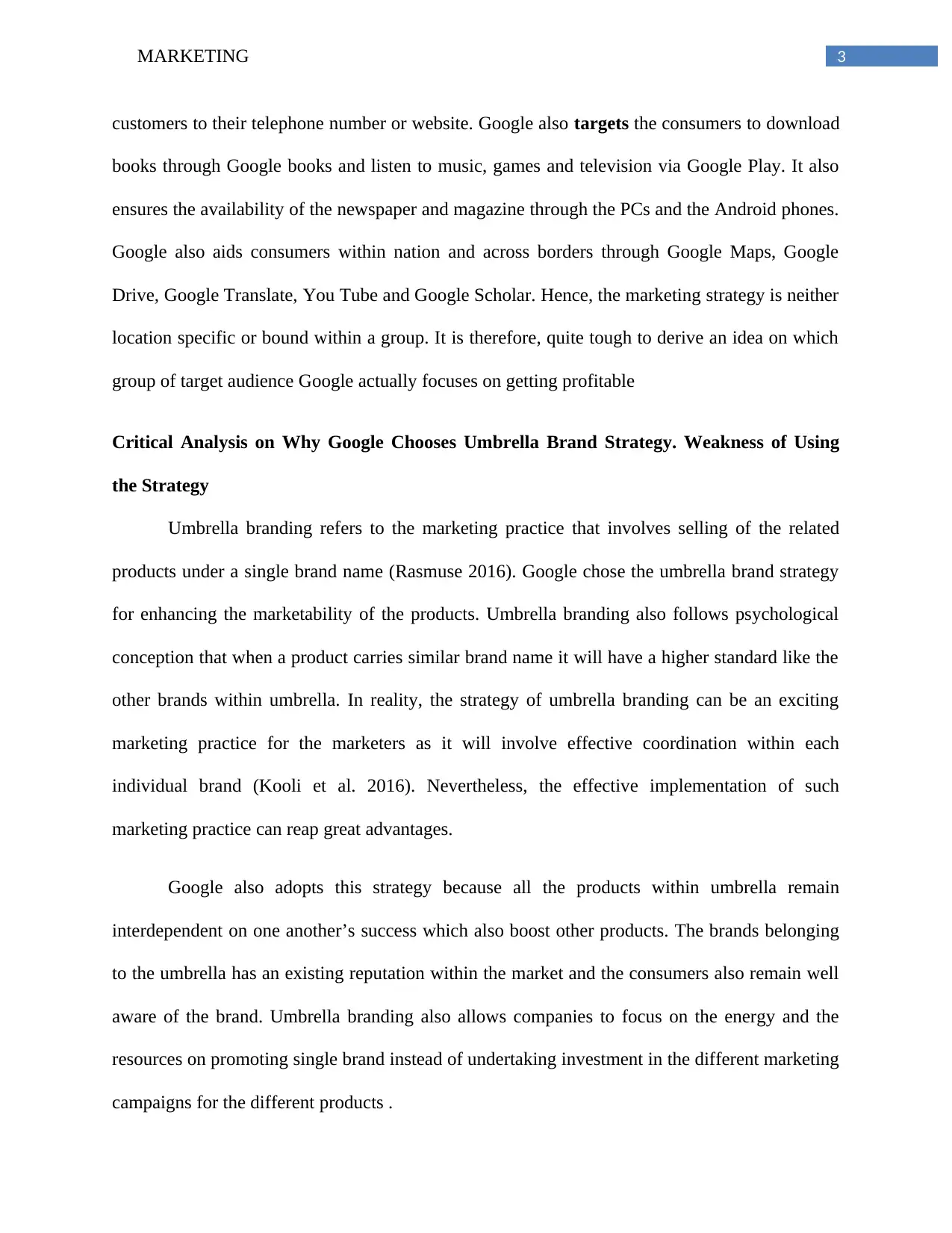
3MARKETING
customers to their telephone number or website. Google also targets the consumers to download
books through Google books and listen to music, games and television via Google Play. It also
ensures the availability of the newspaper and magazine through the PCs and the Android phones.
Google also aids consumers within nation and across borders through Google Maps, Google
Drive, Google Translate, You Tube and Google Scholar. Hence, the marketing strategy is neither
location specific or bound within a group. It is therefore, quite tough to derive an idea on which
group of target audience Google actually focuses on getting profitable
Critical Analysis on Why Google Chooses Umbrella Brand Strategy. Weakness of Using
the Strategy
Umbrella branding refers to the marketing practice that involves selling of the related
products under a single brand name (Rasmuse 2016). Google chose the umbrella brand strategy
for enhancing the marketability of the products. Umbrella branding also follows psychological
conception that when a product carries similar brand name it will have a higher standard like the
other brands within umbrella. In reality, the strategy of umbrella branding can be an exciting
marketing practice for the marketers as it will involve effective coordination within each
individual brand (Kooli et al. 2016). Nevertheless, the effective implementation of such
marketing practice can reap great advantages.
Google also adopts this strategy because all the products within umbrella remain
interdependent on one another’s success which also boost other products. The brands belonging
to the umbrella has an existing reputation within the market and the consumers also remain well
aware of the brand. Umbrella branding also allows companies to focus on the energy and the
resources on promoting single brand instead of undertaking investment in the different marketing
campaigns for the different products .
customers to their telephone number or website. Google also targets the consumers to download
books through Google books and listen to music, games and television via Google Play. It also
ensures the availability of the newspaper and magazine through the PCs and the Android phones.
Google also aids consumers within nation and across borders through Google Maps, Google
Drive, Google Translate, You Tube and Google Scholar. Hence, the marketing strategy is neither
location specific or bound within a group. It is therefore, quite tough to derive an idea on which
group of target audience Google actually focuses on getting profitable
Critical Analysis on Why Google Chooses Umbrella Brand Strategy. Weakness of Using
the Strategy
Umbrella branding refers to the marketing practice that involves selling of the related
products under a single brand name (Rasmuse 2016). Google chose the umbrella brand strategy
for enhancing the marketability of the products. Umbrella branding also follows psychological
conception that when a product carries similar brand name it will have a higher standard like the
other brands within umbrella. In reality, the strategy of umbrella branding can be an exciting
marketing practice for the marketers as it will involve effective coordination within each
individual brand (Kooli et al. 2016). Nevertheless, the effective implementation of such
marketing practice can reap great advantages.
Google also adopts this strategy because all the products within umbrella remain
interdependent on one another’s success which also boost other products. The brands belonging
to the umbrella has an existing reputation within the market and the consumers also remain well
aware of the brand. Umbrella branding also allows companies to focus on the energy and the
resources on promoting single brand instead of undertaking investment in the different marketing
campaigns for the different products .
Paraphrase This Document
Need a fresh take? Get an instant paraphrase of this document with our AI Paraphraser
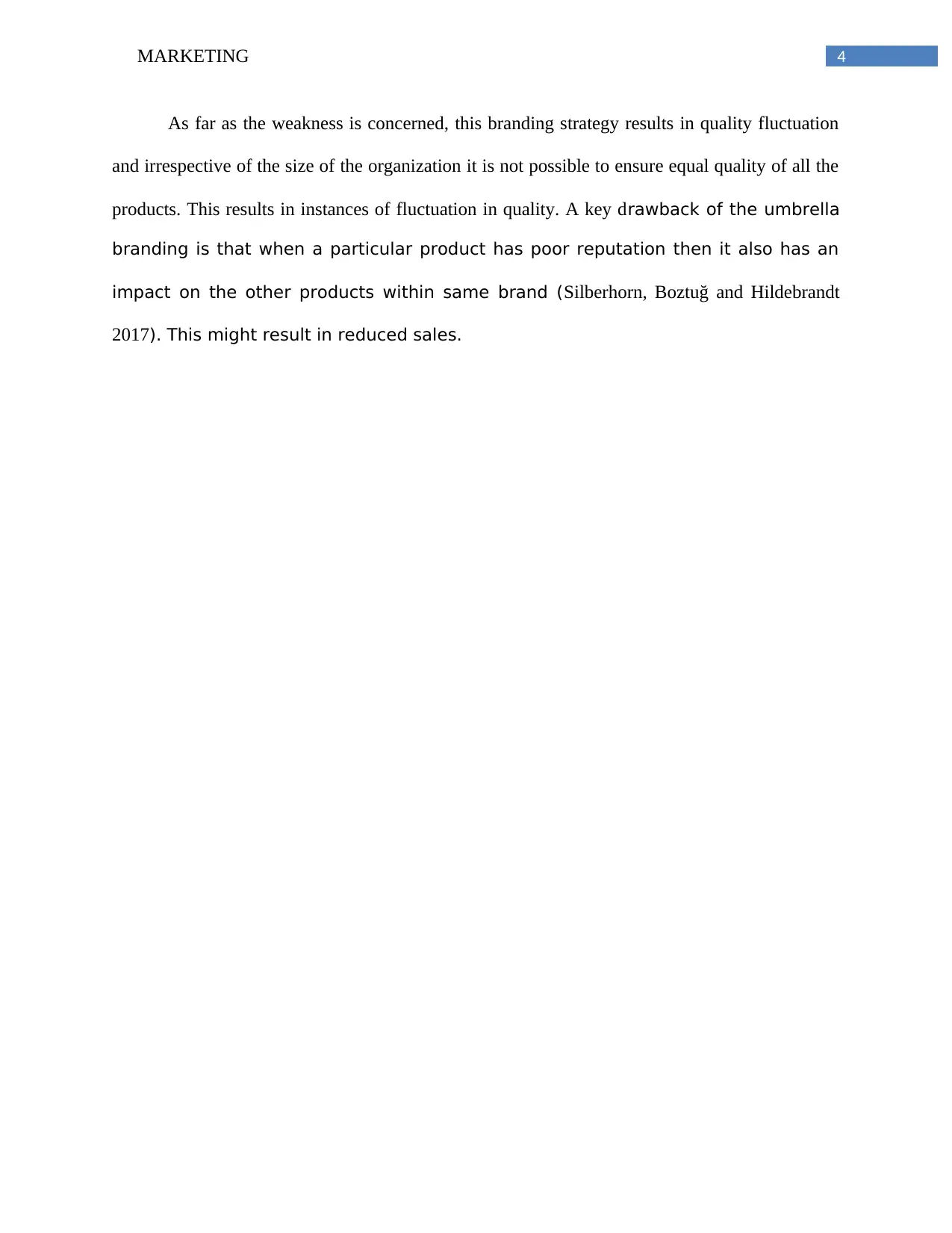
4MARKETING
As far as the weakness is concerned, this branding strategy results in quality fluctuation
and irrespective of the size of the organization it is not possible to ensure equal quality of all the
products. This results in instances of fluctuation in quality. A key drawback of the umbrella
branding is that when a particular product has poor reputation then it also has an
impact on the other products within same brand (Silberhorn, Boztuğ and Hildebrandt
2017). This might result in reduced sales.
As far as the weakness is concerned, this branding strategy results in quality fluctuation
and irrespective of the size of the organization it is not possible to ensure equal quality of all the
products. This results in instances of fluctuation in quality. A key drawback of the umbrella
branding is that when a particular product has poor reputation then it also has an
impact on the other products within same brand (Silberhorn, Boztuğ and Hildebrandt
2017). This might result in reduced sales.
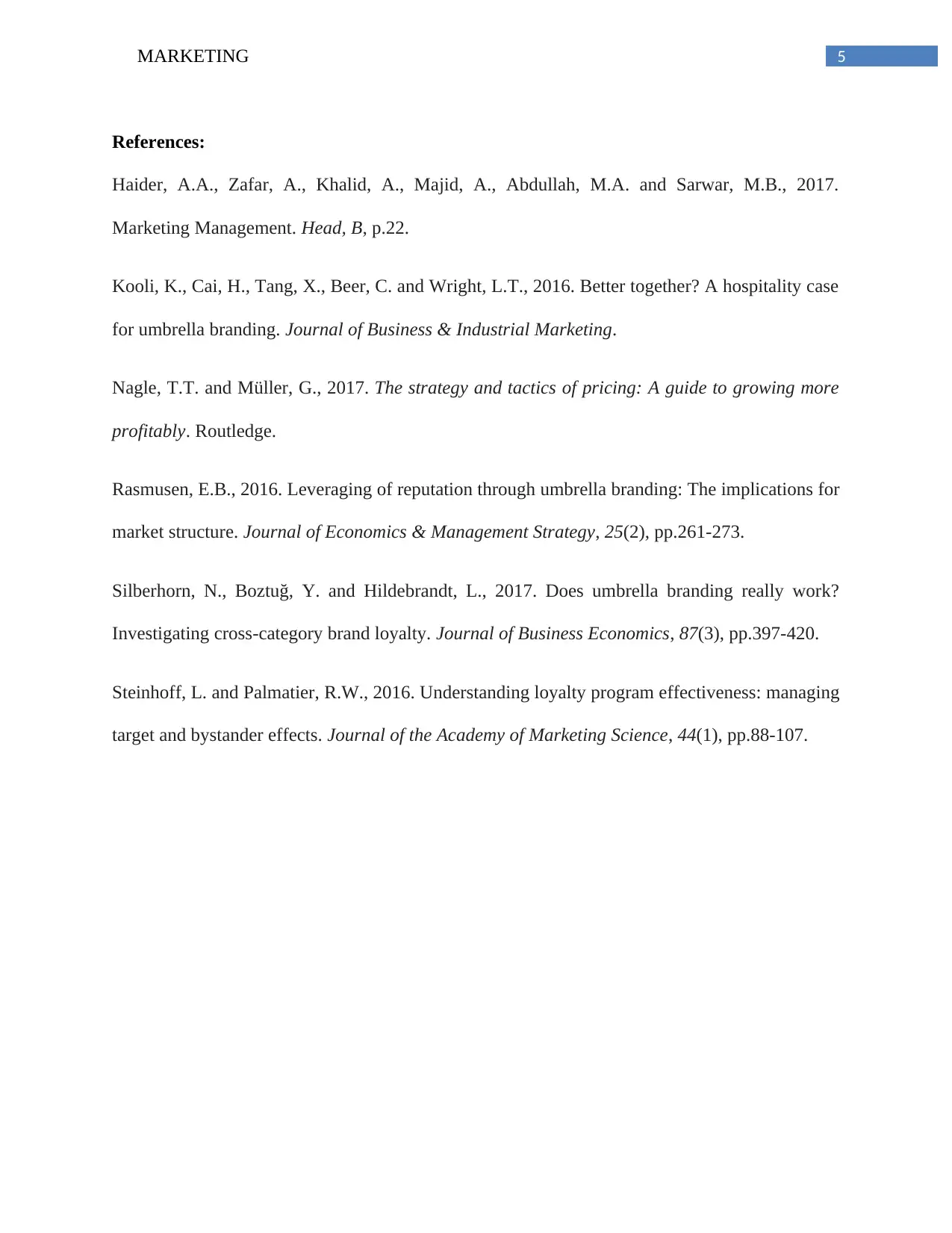
5MARKETING
References:
Haider, A.A., Zafar, A., Khalid, A., Majid, A., Abdullah, M.A. and Sarwar, M.B., 2017.
Marketing Management. Head, B, p.22.
Kooli, K., Cai, H., Tang, X., Beer, C. and Wright, L.T., 2016. Better together? A hospitality case
for umbrella branding. Journal of Business & Industrial Marketing.
Nagle, T.T. and Müller, G., 2017. The strategy and tactics of pricing: A guide to growing more
profitably. Routledge.
Rasmusen, E.B., 2016. Leveraging of reputation through umbrella branding: The implications for
market structure. Journal of Economics & Management Strategy, 25(2), pp.261-273.
Silberhorn, N., Boztuğ, Y. and Hildebrandt, L., 2017. Does umbrella branding really work?
Investigating cross-category brand loyalty. Journal of Business Economics, 87(3), pp.397-420.
Steinhoff, L. and Palmatier, R.W., 2016. Understanding loyalty program effectiveness: managing
target and bystander effects. Journal of the Academy of Marketing Science, 44(1), pp.88-107.
References:
Haider, A.A., Zafar, A., Khalid, A., Majid, A., Abdullah, M.A. and Sarwar, M.B., 2017.
Marketing Management. Head, B, p.22.
Kooli, K., Cai, H., Tang, X., Beer, C. and Wright, L.T., 2016. Better together? A hospitality case
for umbrella branding. Journal of Business & Industrial Marketing.
Nagle, T.T. and Müller, G., 2017. The strategy and tactics of pricing: A guide to growing more
profitably. Routledge.
Rasmusen, E.B., 2016. Leveraging of reputation through umbrella branding: The implications for
market structure. Journal of Economics & Management Strategy, 25(2), pp.261-273.
Silberhorn, N., Boztuğ, Y. and Hildebrandt, L., 2017. Does umbrella branding really work?
Investigating cross-category brand loyalty. Journal of Business Economics, 87(3), pp.397-420.
Steinhoff, L. and Palmatier, R.W., 2016. Understanding loyalty program effectiveness: managing
target and bystander effects. Journal of the Academy of Marketing Science, 44(1), pp.88-107.
⊘ This is a preview!⊘
Do you want full access?
Subscribe today to unlock all pages.

Trusted by 1+ million students worldwide
1 out of 6
Related Documents
Your All-in-One AI-Powered Toolkit for Academic Success.
+13062052269
info@desklib.com
Available 24*7 on WhatsApp / Email
![[object Object]](/_next/static/media/star-bottom.7253800d.svg)
Unlock your academic potential
Copyright © 2020–2025 A2Z Services. All Rights Reserved. Developed and managed by ZUCOL.





